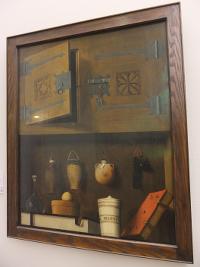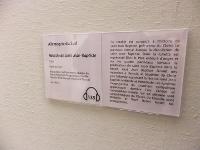***
France/Spain 2011
Day 2 - 18th March - Colmar: Unterlinden Museum (Part 2)
The audioguide was complimentary, so I got to listen to one of the lamest stories I'd ever heard.
In 1720, the leaders of the Collegiate Church of Saint Martin of Colmar church were bored, so they decided to make their altarpiece collapse in front of a crowd on Assumption Day. The altarpiece was damaged and is now incomplete.


Panels of the Altar-Master of the church of St Martin of Colmar. Gaspard Isenmann. 1465: Entry of Christ into Jerusalem, the Last Supper/The Scourging with the Crown of Thorns. Both are in Pilate's Palace.
This is naturalistic


Christ on the Mount of Olives, and the Arrest of Christ
Christ is healing the ear a disciple has cut off. On the right you see the wife of the smith who made the nails for the cross, as retold in the apocryphal gospels


The Deposition ofChrist and the Entombment


The Resurrection
The model for Jerusalem was possibly Salzbourg

Altarpiece for the Collegiate Church of Saint Martin, 1465. How the existing panels would've looked.




Legend of St James: Miracle of the Roasted Chickens. Master of the Legend of St James, ~1470
I like this myth. From Bodegas Altona - Rioja Wine,
"The Miracle of the Cock and the Hen
Tradition tells of a German family, on their way to Santiago de Compostela. When they arrived in Santo Domingo, they stayed in a posada, or inn. The innkeeper's daughter was attracted to the family's son, and let him know it. But the young man spurned the girl's advances, and humiliated, the jilted girl hid a silver goblet in the young pilgrim's pouch. As soon as the family took to the road to continue their journey, the daughter accused him of stealing the goblet. The youth was hanged, but miraculously, he did not die.
When the judge was told about this, he wouldn't accept it; he said he would believe the pilgrim was alive and innocent only if the roasted chickens he was about to enjoy for dinner crowed.
The birds sprung to life and the hen crowed. This miracle is commemorated in the chicken coop inside the cathedral, where a live white cock and hen are always kept. Even today, the crowing of the cock and the hen are considered a sign of good luck."
Incidentally there's a recipe for St James Marinated Chicken. Maybe it's so good my palate will come alive?


Ecce Homo ("Behold the Man"). End of 15th c.


Still Life with bottles and books. North Germany or the Low Countries. ~1530
This is the bottle cabinet of a surgeon. On the right is a bottle for toothache. The ball on top of the brown thing is found in some herbivores' stomachs, and is used for healing.


St Anne, the Virgin and the Infant. End 15th c.


Melancholy, Lucas Cranach l'Ancien
This was on loan
Martin Luther was a friend of Cranach's. He was against melancholy. He believed in the good life - eating, drinking and living well (if I understand my notes correctly) - and god (the fortress on the hill is a reference to Luther's most famous hymn)
The notes add that melancholy - in a religious, even Protestant interpretation - was a temptation of the devil, which the faithful must resist.


St John the Evangelist blesses the cup of poison. Wilhelm Stetter, 1519



Pyramus and Thisbe. ~1506.
This story from Ovid is basically Romeo and Juliet, except a bramble bush is involved (Wikipedia says "the gods listen to Thisbe's lament, and forever change the colour of the mulberry fruits into the stained colour to honour the forbidden love")


Altarpiece of St John the Baptist. 1526.



Virgin and Child on Crescent Moon. End 15th c.


The Flight from Egypt. Schongauer, 1470-5



Domestic Altar: The Annunciation. ~1500




St John the Baptist, St Nicholas. ~1500


The largest collection of virgins in France
Incidentally there was what was probably a lower secondary school group in there at the same time.